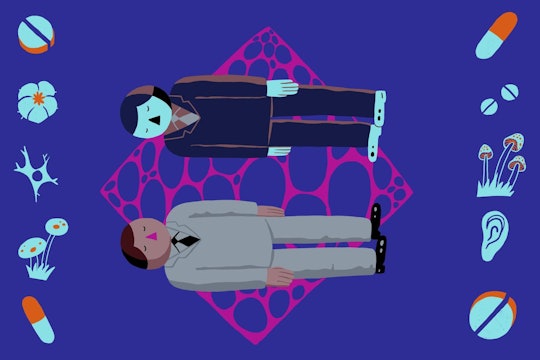
How have mental disorders with hallucinations been treated in the past?
A brief history of treating mental illnesses
Ancient Egyptian, Indian, Greek, and Roman writing describe mental illness as being caused by the wrath of the gods or evil spirits. Hippocrates, a Greek physician who was born in 460 BCE (where the Hippocratic Oath comes from), described physical and mental illness as stemming from an imbalance of what he thought were the body's essential elements — black bile, yellow bile, phlegm, and blood.
In Hippocrates' writing, mental disorders were classified as Mania, Melancholy, Phrenitis (inflammation of the brain), Insanity, Disobedience, Paranoia, Panic, Epilepsy, and Hysteria.
Hippocrates knew these disorders could have different presentations depending on their cause. Mania, for example, was attributed to either excess phlegm or yellow bile — excess phlegm was thought to lead to a quieter mania, while excess yellow bile led to a more frenzied and mischievous mania. Back then, treatment entailed releasing what was considered excess fluid through bloodletting, or by ingesting herbs to induce vomiting or diarrhea.
In the Middle Ages — from the fifth to 15th century — the first mental hospitals and asylums were founded in Baghdad and Cairo, followed later by hospitals in England and Spain. Many were initially privately run, and often religiously affiliated. They were generally described as caring institutions that provided entertainment for the patients (although some have still been described as restraining patients with chains). But mental hospitals didn't really become common in Europe until the 18th and 19th centuries, when public institutions were opened. The first hospital with psychiatric care in the United States — back when it was actually still a colony of Britain — was the Pennsylvania Hospital, which was founded in 1752.
The growth of cities in the 1800s led to a fear of people with mental illness as a threat to public safety and a created a boom in mental asylums as they were built to separate people with mental illness from the rest of society. As more patients became institutionalized, it also, however, allowed physicians to make close clinical observations, and new diagnostic categories were created.
For example, Emil Kraepelin, a German psychiatrist, is credited with popularizing the diagnosis of "dementia praecox," which would later be called schizophrenia, and "manic depression," now known as bipolar disorder. The poor generally found themselves in public asylums, while the wealthy were able to attend private asylums with retreat-like qualities including private parks, greenhouses, and sun parlors.
Wealthy patients with less severe mental health problems such as hysteria, sleep disorders, or alcoholism were able to see doctors instead of being placed in an asylum. One of the commonly used treatments of the 1800s was hypnosis, or putting patients in a trance-like state where they became highly suggestible, and using this to suggest more pleasant thoughts and behaviors. This led to the development of other interventions based on relaxation and suggestion collectively known as "psychotherapy." The term psychotherapy became used to describe any therapy that involves talking about psychological problems as a means of treating them.
Probably the best-known psychotherapy of the time was detailed by Josef Breuer and Sigmund Freud which they outlined in "the talking cure," a case study about a patient called Anna O. In it, they had the patient guide the treatment (which was unusual at the time) by talking freely about whatever was on her mind.
Although it was unclear how effective the treatment was, the approach caught on and was refined into a form of psychotherapy called psychoanalysis, which explores how unconscious motivations and drives impact current functioning. This type of therapy became popular among the upper-middle-class in Vienna and is still used today.
In 1937, over half of all hospital beds were used for psychiatric care, so there was a push to develop new treatments. In the early- to mid-1900s new procedures were developed for patients, especially those in psychiatric hospitals.
One such development was psychosurgery, most (in)famously the prefrontal lobotomy, in which surgeons severed connections in part of the frontal lobe. Although the practice won a Nobel Prize at the time, it was soon recognized as largely harmful to patients, and less effective than subsequently discovered psychiatric medications.
In the 1950s, the “psychopharmacological revolution” in psychiatry began with the identification of two medications called chlorpromazine (a chemically-synthesized compound that affects dopamine signaling in the brain), and reserpine (a natural substance obtained from the root of a flower that affects norepinephrine, dopamine, and serotonin).
These medications were found to be effective in treating psychosis, calming patients without making them unresponsive. The success of these treatments stimulated interest in psychopharmacological research and led to an explosion of new discoveries. There are now a number of broad categories of psychiatric medications available to treat psychiatric conditions.
